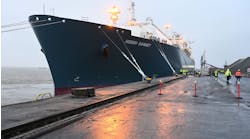The merger between Noble Drilling and Maersk Drilling will create the world’s third’s largest offshore rig owner, with the combined company having 19 jackups, 15 drillships, and five semisubmersibles.
The merger will not only create an industry giant, but also make the new Noble Corp. an even stronger player in the ultra-deepwater and harsh environment jackup markets. The combined entity will own the second largest fleet of seventh-generation drillships, while it will own the largest fleet of harsh environment jackups globally. At the same time, the merger of the two companies is expected to result in significant consolidation within both the North Sea jackup and ultra-deepwater floater markets.
The new merged entity will have 39 rigs, barring divestments, placing it behind only Valaris and China Oilfield Services Ltd. (COSL) in terms of fleet size. Meanwhile, some estimates indicate that the combined market capitalization of the two companies could be as much as ~$3.4 billion, which would make it the leading rig contractor in terms of market capital, surpassing Valaris at ~$2.8 billion, according to Esgian Rig Analytics.
Among the 15 drillships only one is more than 10 years old with the remainder averaging 8.1 years. Two of the vessels, currently cold stacked, are the only ones not contracted or committed for future work. Five of the 13 others have contracts that end in the first half of next year, although only two have options that would keep them employed through 2022 or beyond.
Average day rate is around $223,776, with one vessel on just below $200,000, according to Westwood Global Energy Group’s RigLogix division. The firm notes these levels are notably below the average day rates secured by Transocean, which would operate the fourth-largest overall rig fleet. Some Transocean drillships are earning $450,000/d plus, based on long-term contracts signed during 2011-2013. The addition of the four Maersk drillships may lead Noble to dispose of some of the former Pacific Drilling vessels it had contemplated retiring, Westwood says.
The Noble/Maersk semisubmersible fleet will comprise five semis, four from Maersk and one from Noble. One of the five is cold stacked, while the other four are contracted.
The Noble Clyde Boudreaux is due to come off a contract this month, but a follow-up deal may be in place for an assignment in Southeast Asia, while the other four Maersk semis will stay on contracts until July 2022.
The average age of the fleet is 17.7 years, with current average day rates for three of the four rigs of $212,662, including the 34-year-old Boudreaux’s current $117,000. Average day rates for semis owned by Odfjell, Transocean, and Seadrill are higher, Westwood notes, but their fleets include harsh-environment semis working offshore Norway, which command higher fees than the rest of the world.
The combined Noble/Maersk jackup fleet will comprise 11 rigs from Maersk and eight from Noble, with current utilization at 79%. Three of the jackups have recently become idle. However, one, currently in the North Sea, is said to be in the running for a contract in the Middle East. Two of the 15 contracted rigs are due to finish contracts this year, while five have assignments into 4Q 2022 or later.
The average day rate for the Noble/Maersk harsh-environment jackups is said to be $311,000, according to Westwood, with the remainder of the fleet thought to be averaging around $96,000. And although seven of the fleet are 12 years old or more, the average age is 9.5 years.
Outside of the day rates, the combined company will have the second-youngest fleet among its peers and a near 80% utilization, with only four idle rigs.
The new company, named Noble Corporation, will be listed on the New York Stock Exchange and Nasdaq Copenhagen, with the merger potentially closing in mid-2022. It will be headquartered in Houston but will also maintain an operating presence in Stavanger to support Norwegian and wider North Sea customers.




